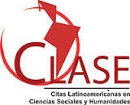Métodos Mistos na Análise de Redes Sociais: Integrações, Virtudes e Desafios
DOI:
https://doi.org/10.5433/2176-6665.2022v27n2e45688Palavras-chave:
Análise de redes sociais, Métodos mistos, Crime, SegurançaResumo
A Análise de Redes Sociais (ARS) tem conquistado espaço nas ciências sociais brasileiras, mas ainda carecemos de discussões metodológicas a respeito de sua integração com métodos qualitativos. Este artigo esboça notas introdutórias aos métodos mistos na ARS. Estas notas são destinadas às pesquisas empíricas de diferentes áreas temáticas, com exemplos sobre crime e segurança. O artigo discute forças e fraquezas dos métodos quantitativos e qualitativos na ARS, tipologias de desenhos e estratégias de como integrá-los, virtudes e propósitos das integrações, bem como desafios práticos e problemas fundamentais.
Downloads
Referências
BAKER-DOYLE, Kira. Stories in networks and networks in stories: a tri-modal model for mixed-methods social network research on teachers. International Journal of Research & Method in Education, Mandsaur, v. 38, n. 1, p. 72-82, 2015. Doi: https://doi.org/10.1080/1743727X.2014.911838 DOI: https://doi.org/10.1080/1743727X.2014.911838
BELLOTTI, Elisa. Comment on Nick Crossley/1. Sociologica, Bologna, v. 4, n. 1, p. 1-8, 2010.
BOLÍBAR, Mireia. Macro, meso, micro: broadening the 'social' of social network analysis with a mixed methods approach. Quality & Quantity, Amsterdã, v. 50, p. 2217-2236, 2016. Doi: https://doi.org/10.1007/s11135-015-0259-0 DOI: https://doi.org/10.1007/s11135-015-0259-0
BREWER, Russell. Policing the waterfront: networks, partnerships, and the governance of port security. Oxford: Oxford University Press, 2014. Doi: https://doi.org/10.1093/acprof:oso/9780199687367.001.0001 DOI: https://doi.org/10.1093/acprof:oso/9780199687367.001.0001
CAMPANA, Paolo; VARESE, Federico. Listening to the wire: criteria and techniques for the quantitative analysis of phone intercepts. Trends in Organized Crime, New York, v. 15, n. 1, p. 13-30, 2012. Doi: https://doi.org/10.1007/s12117-011-9131-3 DOI: https://doi.org/10.1007/s12117-011-9131-3
CARRINGTON, Peter. Social network research. In: DOMÍNGUEZ, Silvia; HOLLSTEIN, Betina (ed.). Mixed methods social networks research: design and applications. New York: Cambridge University Press, 2014. p. 35-64. Doi: https://doi.org/10.1017/CBO9781139227193.004 DOI: https://doi.org/10.1017/CBO9781139227193.004
CONTI, Norman; DOREIAN, Patrick. Social network engineering and race in a police academy: a longitudinal analysis. Social Networks, Amsterdam, v. 32, p. 30-43, 2010. Doi: https://doi.org/10.1016/j.socnet.2009.08.001 DOI: https://doi.org/10.1016/j.socnet.2009.08.001
COUTO, Vinicius; BEATO FILHO Claudio. Milícias: o crime organizado por meio de uma análise das redes sociais. Revista Brasileira de Sociologia, Porto Alegre, v. 7, n. 17, p. 201-221, 2019. Doi: https://doi.org/10.20336/rbs.480 DOI: https://doi.org/10.20336/rbs.480
COVIELLO, Nicole. Integrating qualitative and quantitative techniques in network analysis. Qualitative Market Research, Bradford, v. 8, n. 1, p. 39-60, 2005. Doi: https://doi.org/10.1108/13522750510575435 DOI: https://doi.org/10.1108/13522750510575435
CRESWELL, John. Research design: qualitative, quantitative, and mixed methods approaches. 3th. ed. Thousand Oaks, CA: SAGE, 2009.
CROSS, Jennifer; DICKMANN, Ellyn; NEWMAN-GONCHAR, Rebecca; FAGAN, Jesse Michael. Using mixed-method design and network analysis to measure development of interagency collaboration. American Journal of Evaluation, New York, v. 30, n. 3, p. 310-329, 2009. Doi: https://doi.org/10.1177/1098214009340044 DOI: https://doi.org/10.1177/1098214009340044
CROSSLEY, Nick. The social world of the network: combining qualitative and quantitative elements in social network analysis. Sociologica, Bologna, v. 4, n. 1, p. 1-34, 2010.
CROSSLEY, Nick; EDWARDS, Gemma. Cases, mechanisms and the real: the theory and methodology of mixed-method social network analysis. Sociological Research Online, London, v. 21, n. 2, p. 1-15, 2016. Doi: https://doi.org/10.5153/sro.3920 DOI: https://doi.org/10.5153/sro.3920
CURTIS, Richard; FRIEDMAN, Samuel R.; NEAIGUS, Alan. JOSE, Benny; GOLDSTEIN, Marjorie; ILDEFONSO, Gilbert. Street-level drug markets: network structure and HIV risk. Social Networks, Amsterdam, v. 17, p. 229-249, 1995. Doi: https://doi.org/10.1016/0378-8733(95)00264-O DOI: https://doi.org/10.1016/0378-8733(95)00264-O
DELLA PORTA, Donatella; KEATING, Michael. How many approaches in the social sciences? An epistemological introduction. In: DELLA PORTA, Donatella; KEATING, Michael (org.). Approaches and methodologies in the social sciences. New York: Cambridge University Press, 2008. p. 19-39. Doi: https://doi.org/10.1017/CBO9780511801938.003 DOI: https://doi.org/10.1017/CBO9780511801938.003
DUPONT, Benoît. Delivering security through networks: surveying the relational landscape of security managers in an urban setting. Crime, Law & Social Change, Dordrecht, v. 45, p. 165-184, 2006. Doi: https://doi.org/10.1007/s10611-006-9033-5 DOI: https://doi.org/10.1007/s10611-006-9033-5
EDWARDS, Gemma. Mixed-method approaches to social network analysis. Southampton: National Centre for Research Methods, 2010. (Review Paper)
EMIRBAYER, Mustafa. Manifesto for a relational sociology. American Journal of Sociology, Chicago, v. 103, n. 2, p. 281-317, 1997. Doi: https://doi.org/10.1086/231209 DOI: https://doi.org/10.1086/231209
EMIRBAYER, Mustafa; GOODWIN, Jeff. Network analysis, culture, and the problem of agency. American Journal of Sociology, Chicago, v. 99, n. 6, p. 1411-1454, 1994.Doi: https://doi.org/10.1086/230450 DOI: https://doi.org/10.1086/230450
FROEHLICH, Dominik; VAN WAES, Sara; SCHÄFER, Hannah. Linking quantitative and qualitative network approaches: a review of mixed methods social network analysis in education research. Review of Research in Education, Itasca, v. 44, n. 1, p. 244-268, 2020. Doi: https://doi.org/10.3102/0091732X20903311 DOI: https://doi.org/10.3102/0091732X20903311
FUHSE, Jan; MÜTZEL, Sophie. Tackling connections, structure, and meaning in networks: quantitative and qualitative methods in sociological network research. Quality & Quantity, Amsterdã, v. 45, p. 1067-1089, 2011. Doi: https://doi.org/10.1007/s11135-011-9492-3 DOI: https://doi.org/10.1007/s11135-011-9492-3
GRANOVETTER, Mark. The strength of weak ties. American Journal of Sociology, Chicago, v. 78, n. 6, p. 1360-1380, 1973. Doi: https://doi.org/10.1086/225469 DOI: https://doi.org/10.1086/225469
HEATH, Sue; FULLER, Alison; JOHNSTON, Brenda. Chasing shadows: defining network boundaries in qualitative social network analysis. Qualitative Research, London, v. 9, n. 5, p. 645-661, 2009. Doi: https://doi.org/10.1177/1468794109343631 DOI: https://doi.org/10.1177/1468794109343631
HERZ, Andreas; PETERS, Luisa; TRUSCHKAT, Inga. How to do qualitative structural analysis: the qualitative interpretation of network maps and narrative interviews. Forum: Qualitative Social Research, Belim, v. 16, n. 1, p. 1-24, 2015.
HIGGINS, Silvio Salej; RIBEIRO, Antônio Carlos. Análise de redes em Ciências Sociais. Brasília: Enap, 2018.
HOLLSTEIN, Betina. Qualitative approaches. In: SCOTT, John; CARRINGTON, Peter (ed.). The SAGE handbook of social network analysis. London: SAGE, 2011. p. 404-416. DOI: https://doi.org/10.4135/9781446294413.n27
HOLLSTEIN, Betina. Mixed methods social networks research: an introduction. In: DOMÍNGUEZ, Silvia; HOLLSTEIN, Betina. Mixed methods social networks research: designs and applications. New York: Cambridge University Press, 2014. p. 3-34. Doi: https://doi.org/10.4135/9781446294413.n27 DOI: https://doi.org/10.1017/CBO9781139227193.003
JOHNSON, R. Burke; ONWUEGBUZIE, Anthony; TURNER, Lisa. Toward a definition of mixed methods research. Journal of Mixed Methods Research, Michigan, v. 1, n. 2, p. 112-133, 2007. Doi: https://doi.org/10.1177/1558689806298224 DOI: https://doi.org/10.1177/1558689806298224
LAZEGA, Emmanuel. Network analysis and qualitative research: a method of contextualization. In: MILLER, Gale; DINGWALL, Robert. (ed.). Context and method in qualitative research. London: SAGE, 1997. p. 119-138. Doi: https://doi.org/10.4135/9781849208758.n9 DOI: https://doi.org/10.4135/9781849208758.n9
MISCHE, Ann. Relational sociology, culture, and agency. In: SCOTT, John; CARRINGTON, Peter (ed.). The SAGE handbook of social network analysis. London: SAGE, 2011. p. 80-97. Doi: https://doi.org/10.4135/9781446294413.n7 DOI: https://doi.org/10.4135/9781446294413.n7
MIZRUCHI, Mark. Social network analysis: recent achievements and current controversies. Acta Sociologica, Oslo, v. 37, p. 329-343, 1994. Doi: https://doi.org/10.1177/000169939403700403 DOI: https://doi.org/10.1177/000169939403700403
MORSELLI, Carlo. Structuring Mr. Nice: entrepreneurial opportunities and brokerage positioning in the cannabis trade. Crime, Law & Social Change, Dordrecht, v. 35, p. 203-244, 2001. Doi: https://doi.org/10.1023/A:1011272411727 DOI: https://doi.org/10.1023/A:1011272411727
MELLO NETO, David Maciel de. Self-regenerating crime: the resilient network of a sector of Rio de Janeiro's drug trafficking in the 1970s. Dilemas: Revista de Estudos de Conflito e Controle Social, v. 14, n. 1, p. 107-133, 2021. Doi: https://doi.org/10.17648/dilemas.v14n1.28173 DOI: https://doi.org/10.17648/dilemas.v14n1.28173
NOORAIE, Reza; SALE, Joanna E. M.; MARIN, Alexandra; ROSS, Lori E. Social network analysis: an example of fusion between quantitative and qualitative methods. Journal of Mixed Methods Research, Rio de Janeiro, v. 14, n. 1, p. 110-124, 2020. Doi: https://doi.org/10.1177/1558689818804060 DOI: https://doi.org/10.1177/1558689818804060
OLIVEIRA, Fabiana. Triangulação metodológica e abordagem multimétodo na pesquisa sociológica: vantagens e desafios. Ciências Sociais Unisinos, São Leopoldo, v. 51, n. 2, p. 133-143, 2015. Doi: https://doi.org/10.4013/csu.2015.51.2.03 DOI: https://doi.org/10.4013/csu.2015.51.2.03
PATRIARCA, Gabriel. A âncora da segurança: centralidades e capitais na rede de segurança do porto de Santos. Lua Nova, n. 114, p. 69-104, 2021. Doi: https://doi.org/10.1590/0102-069104/114. DOI: https://doi.org/10.1590/0102-069104/114
PATRIARCA, Gabriel; LOPES, Cleber da Silva; FERREIRA, Anderson Alexandre. Crimes como redes: as contribuições da Análise de Redes Sociais para a compreensão e o combate da criminalidade violenta. In: MELO, Silas; MASULLO, Yata; CARVALHO, Dionatan (org.). Crime e território: estudos e experiências em políticas de segurança pública. São Luís: IMESC, 2021, p. 204-221.
PAVEZ, Thais; REGINA, Thais; GONÇALVES, Pavez Renata da Rocha; TOLEDO, Demétrio Gaspari Cirne de; CARDOSO, Sara Azevedo. Redes sociais e segurança pública: características e reflexões à luz do processo preparatório para a 1ª Conseg. Revista Brasileira de Segurança Pública, São Paulo, v. 5, n. 2, p. 178-192, 2011. DOI: https://doi.org/10.31060/rbsp.2011.v5.n2.105
RIBEIRO, Ludmila; OLIVEIRA, Victor Neiva e; CREPALDE, Neylson; BASTOS, Luiza Meira; MAIA, Yolanda Campos. Agentes penitenciários aprisionados em suas redes? Revista Brasileira de Ciências Sociais, São Paulo, v. 34, n. 101, p. 1-22, 2019. Doi: https://doi.org/10.1590/3410115/2019 DOI: https://doi.org/10.1590/3410115/2019
RICE, Eric; HOLLOWAY, Ian W.; BARMAN-ADHIKARI, Anamika; FUENTES, Dahlia; BROWN, C Hendricks; PALINKAS, Lawrence A. A mixed methods approach to network data collection. Field Methods, Thousand Oaks, v. 26, n. 3, p. 252-268, 2014. Doi: https://doi.org/10.1177/1525822X13518168 DOI: https://doi.org/10.1177/1525822X13518168
RYAN, Louise; D'ANGELO, Alessio. Changing times: migrant's social network analysis and the challenges of longitudinal research. Social Networks, Amsterdam,v. 53, p. 148-158, 2018. Doi: https://doi.org/10.1016/j.socnet.2017.03.003 DOI: https://doi.org/10.1016/j.socnet.2017.03.003
SANDELOWSKI, Margarete; VOILS, Corrine; KNAFL, George. On quantitizing. Journal of Mixed Methods Research, Thousand Oaks, v. 3, n. 3, p. 208-222, 2009. Doi: https://doi.org/10.1177/1558689809334210 DOI: https://doi.org/10.1177/1558689809334210
SCOTT, John. Social network analysis: a handbook. 2nd ed. London: Sage, 2000.
SMALL, Mario Luis. How to conduct a mixed methods study: recent trends in a rapidly growing literature. Annual Review of Sociology, Palo Alto, v. 37, n. 1, p. 57-86, 2011. Doi: https://doi.org/10.1146/annurev.soc.012809.102657 DOI: https://doi.org/10.1146/annurev.soc.012809.102657
SOMERS, Margaret. "We're no angels": realism, rational choice, and relationality in social science. American Journal of Sociology, Chicago, v. 104, n. 3, p. 722-784, 1998. Doi: https://doi.org/10.1086/210085 DOI: https://doi.org/10.1086/210085
TEDDLIE, Charles; TASHAKKORI, Abbas. A general typology of research designs featuring mixed methods. Research in the Schools, Washington, v. 13, n. 1, p. 12-28, 2006.
TUBARO, Paola; RYAN, Louise; D'ANGELO, Alessio. The visual sociogram in qualitative and mixed-methods research. Sociological Research Online, London, v. 21, n. 2, p. 1-18, 2016. Doi: https://doi.org/10.5153/sro.3864 DOI: https://doi.org/10.5153/sro.3864
WHITE, Harrison. Identity and control: a structural theory of social action. Princeton: Princeton University Press, 1992.
WILLIAMS, Trenton; SHEPHERD, Dean. Mixed method social network analysis: combining inductive concept development, content analysis, and secondary data for quantitative analysis. Organizational Research Methods, Amsterdam, v. 20, n. 2, p. 268-298, 2017. DOI: https://doi.org/10.1177/1094428115610807
Downloads
Publicado
Como Citar
Edição
Seção
Licença
Copyright (c) 2022 Gabriel Patriarca

Este trabalho está licenciado sob uma licença Creative Commons Attribution 4.0 International License.
Os direitos autorais relativos aos artigos publicados em Mediações são do(a)s autore(a)s; solicita-se aos(às) autore(a)s, em caso de republicação parcial ou total da primeira publicação, a indicação da publicação original no periódico.
Mediações utiliza a licença Creative Commons Attribution 4.0 International, que prevê Acesso Aberto, facultando a qualquer usuário(a) a leitura, o download, a cópia e a disseminação de seu conteúdo, desde que adequadamente referenciado.
As opiniões emitidas pelo(a)s autore(a)s dos artigos são de sua exclusiva responsabilidade.
Dados de financiamento
-
Fundação de Amparo à Pesquisa do Estado de São Paulo
Números do Financiamento Processo: 2021/02709-3




































